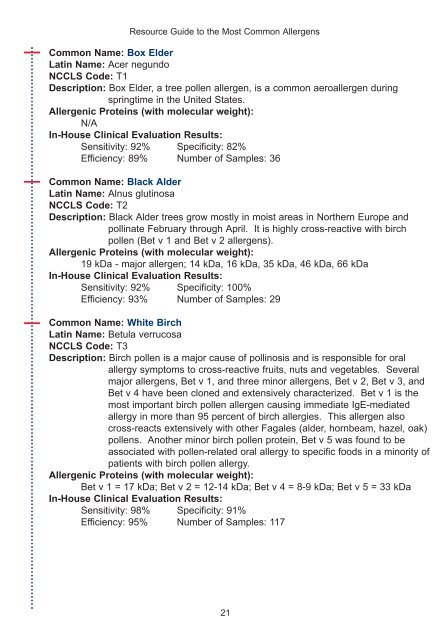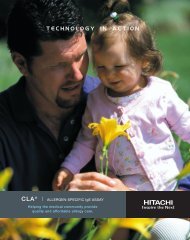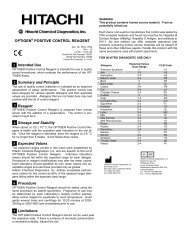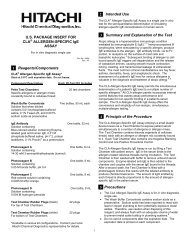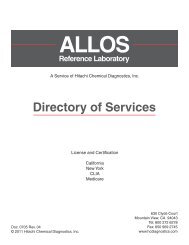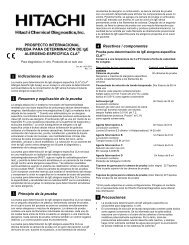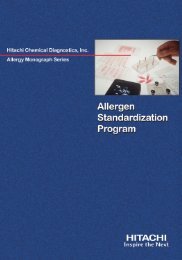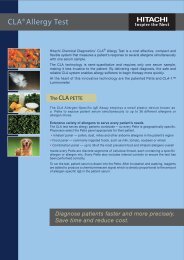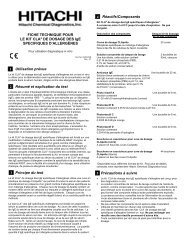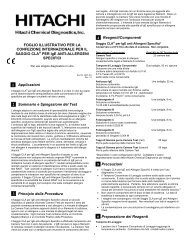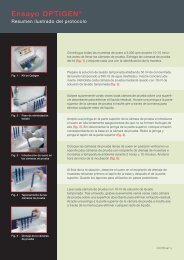Allergen Resource Guide - Hitachi Chemical Diagnostics
Allergen Resource Guide - Hitachi Chemical Diagnostics
Allergen Resource Guide - Hitachi Chemical Diagnostics
Create successful ePaper yourself
Turn your PDF publications into a flip-book with our unique Google optimized e-Paper software.
<strong>Resource</strong> <strong>Guide</strong> to the Most Common <strong>Allergen</strong>s<br />
Common Name: Box Elder<br />
Latin Name: Acer negundo<br />
NCCLS Code: T1<br />
Description: Box Elder, a tree pollen allergen, is a common aeroallergen during<br />
springtime in the United States.<br />
<strong>Allergen</strong>ic Proteins (with molecular weight):<br />
N/A<br />
In-House Clinical Evaluation Results:<br />
Sensitivity: 92% Specificity: 82%<br />
Efficiency: 89% Number of Samples: 36<br />
Common Name: Black Alder<br />
Latin Name: Alnus glutinosa<br />
NCCLS Code: T2<br />
Description: Black Alder trees grow mostly in moist areas in Northern Europe and<br />
pollinate February through April. It is highly cross-reactive with birch<br />
pollen (Bet v 1 and Bet v 2 allergens).<br />
<strong>Allergen</strong>ic Proteins (with molecular weight):<br />
19 kDa - major allergen; 14 kDa, 16 kDa, 35 kDa, 46 kDa, 66 kDa<br />
In-House Clinical Evaluation Results:<br />
Sensitivity: 92% Specificity: 100%<br />
Efficiency: 93% Number of Samples: 29<br />
Common Name: White Birch<br />
Latin Name: Betula verrucosa<br />
NCCLS Code: T3<br />
Description: Birch pollen is a major cause of pollinosis and is responsible for oral<br />
allergy symptoms to cross-reactive fruits, nuts and vegetables. Several<br />
major allergens, Bet v 1, and three minor allergens, Bet v 2, Bet v 3, and<br />
Bet v 4 have been cloned and extensively characterized. Bet v 1 is the<br />
most important birch pollen allergen causing immediate IgE-mediated<br />
allergy in more than 95 percent of birch allergies. This allergen also<br />
cross-reacts extensively with other Fagales (alder, hornbeam, hazel, oak)<br />
pollens. Another minor birch pollen protein, Bet v 5 was found to be<br />
associated with pollen-related oral allergy to specific foods in a minority of<br />
patients with birch pollen allergy.<br />
<strong>Allergen</strong>ic Proteins (with molecular weight):<br />
Bet v 1 = 17 kDa; Bet v 2 = 12-14 kDa; Bet v 4 = 8-9 kDa; Bet v 5 = 33 kDa<br />
In-House Clinical Evaluation Results:<br />
Sensitivity: 98% Specificity: 91%<br />
Efficiency: 95% Number of Samples: 117<br />
21


